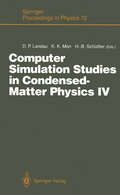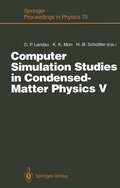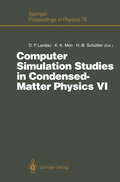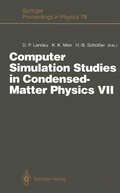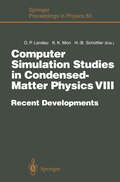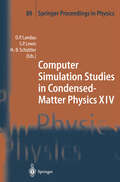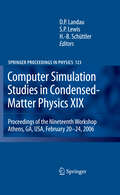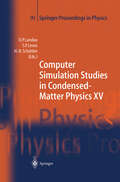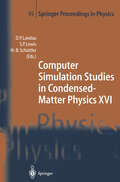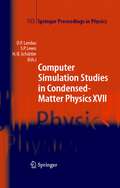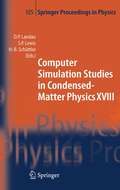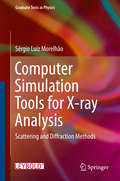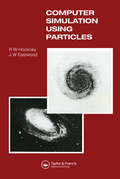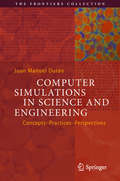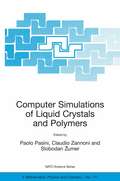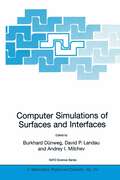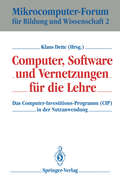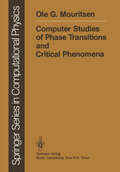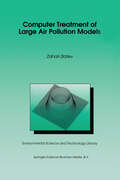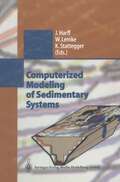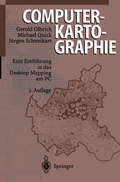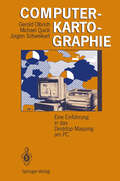- Table View
- List View
Computer Simulation Studies in Condensed-Matter Physics IV: Proceedings of the Fourth Workshop, Athens, GA, USA, February 18–22, 1991 (Springer Proceedings in Physics #72)
by David P. Landau K. K. Mon Heinz-Bernd SchüttlerThe contribution of computer simulation studies to our understanding of proper ties of a wide range of condensed-matter systems is now well established. The Center for Simulational Physics has been hosting annual workshops with the in tent of bringing together some of the experienced practitioners in the field, as well as relative newcomers in the field, to provide a forum for the exchange of ideas and recent results. This year's workshop, the fourth in the series, was held at the University of Georgia, February 18-22, 1991. These proceedings are a record of the workshop and are published with the goal of timely dissemination of the papers to a wider audience. The proceedings are divided into three parts. The first part contains invited papers which deal with simulational studies of classical systems and includes an introduction to some new simulation techniques and special purpose comput ers as well. A separate section of the proceedings is devoted to invited papers on quantum systems including new results for strongly correlated electron and quantum spin models believed to be important for the description of high-T c superconductors. The contributed presentations comprise the final chapter.
Computer Simulation Studies in Condensed-Matter Physics V: Proceedings of the Fifth Workshop Athens, GA, USA, February 17–21, 1992 (Springer Proceedings in Physics #75)
by David P. Landau K. K. Mon Heinz-Bernd SchüttlerAs the role of computer simulations began to increase in importance, we sensed a need for a "meeting place" for both experienced simulators and neophytes to discuss new techniques and results in an evironment which promotes extended discussion. As a consequence of these concerns, The Center for Simulational Physics established an annual workshop on Recent Developments in Computer Simulation Studies in Condensed-Matter Physics. This year's workshop was the fifth in this series and the interest which the scientific community has shown demonstrates quite clearly the useful purpose which the series has served. The workshop was held at the University of Georgia, February 17-21, 1992, and these proceedings form a record of the workshop which is published with the goal of timely dissemination of the papers to a wider audience. The proceedings are divided into four parts. The first part contains invited papers which deal with simulational studies of classical systems and includes an introduction to some new simulation techniques and special purpose computers as well. A separate section of the proceedings is devoted to invited papers on quantum systems including new results for strongly correlated electron and quan tum spin models. The third section is comprised of a single, invited description of a newly developed software shell designed for running parallel programs. The contributed presentations comprise the final chapter.
Computer Simulation Studies in Condensed-Matter Physics VI: Proceedings of the Sixth Workshop, Athens, GA, USA, February 22–26, 1993 (Springer Proceedings in Physics #76)
by David P. Landau K. K. Mon Heinz-Bernd SchüttlerComputer Simulation Studies in Condensed-Matter Physics VI provides a broad overview of recent developments in this field. Based on the last workshop, it presents invited and contributed papers which describe new physical results, simulational techniques and ways of interpreting simulational data. Both classical and quantum systems are discussed.
Computer Simulation Studies in Condensed-Matter Physics VII: Proceedings of the Seventh Workshop Athens, GA, USA, 28 February – 4 March 1994 (Springer Proceedings in Physics #78)
by David P. Landau K. K. Mon Heinz-Bernd SchüttlerComputer Simulation Studies in Condensed-Matter Physics VII provides a broad overview of recent developments. Presented at the recent workshop, it contains the invited and contributed papers which describe new physical results, simulational techniques and ways of interpreting simulational data. Both classical and quantum systems are discussed.
Computer Simulation Studies in Condensed-Matter Physics VIII: Recent Developments Proceedings of the Eighth Workshop Athens, GA, USA, February 20–24, 1995 (Springer Proceedings in Physics #80)
by David P. Landau Kin-Keung Mon Heinz-Bernd SchüttlerComputer Simulation Studies in Condensed-Matter Physics VIII covers recent developments in this field presented at the 1995 workshop, such as new algorithms, methods of analysis, and conceptual developments. This volume is composed of three parts. The first part contains invited papers that deal with simulational studies of classical systems. The second part is devoted to invited papers on quantum systems, including new results for strongly correlated electron and quantum spin models. The final part comprises contributed presentations.
Computer Simulation Studies in Condensed-Matter Physics XIV: Proceedings of the Fourteenth Workshop, Athens, GA, USA, February 19–24, 2001 (Springer Proceedings in Physics #89)
by D. P. Landau S. P. Lewis H. B. SchüttlerOver the last 30 years, Professor David P. Landau's trailblazing research achievements and influential leadership have helped establish computer sim ulation as a powerful and incisive mode of scientific investigation, now on a par in the physical sciences with experimental and theoretical research. This year, we were very pleased to organize a special one-day symposium honor ing the 60th birthday of our distinguished colleague and friend. This event was held in conjunction with and immediately following the annual computer simulations workshop that Professor Landau founded 14 years ago. Many of the papers presented at this honorary symposium are integrated into this pro ceedings volume, and the accompanying photograph of participants serves to commemorate this very special event. This volume contains both invited papers and contributed presentations on problems in both classical and quantum condensed matter physics. We hope that each reader will benefit from specialized results as well as profit from exposure to new algorithms, methods of analysis, and conceptual devel opments.
Computer Simulation Studies in Condensed-Matter Physics XIX: Proceedings of the Nineteenth Workshop Athens, GA, USA, February 20--24, 2006 (Springer Proceedings in Physics #123)
by David P. Landau Steven P. Lewis Heinz-Bernd SchüttlerThis status report features the most recent developments in the field, spanning a wide range of topical areas in the computer simulation of condensed matter/materials physics. Both established and new topics are included, ranging from the statistical mechanics of classical magnetic spin models to electronic structure calculations, quantum simulations, and simulations of soft condensed matter.
Computer Simulation Studies in Condensed-Matter Physics XV: Proceedings of the Fifteenth Workshop Athens, GA, USA, March 11–15, 2002 (Springer Proceedings in Physics #90)
by David P. Landau Steven P. Lewis Heinz-Bernd SchüttlerOver fifteen years ago, because of the tremendous increase in the power and utility of computer simulations, The University of Georgia formed the first institutional unit devoted to the use of simulations in research and teach ing: The Center for Simulational Physics. As the international simulations community expanded further, we sensed a need for a meeting place for both experienced simulators and neophytes to discuss new techniques and recent results in an environment which promoted lively discussion. As a consequence, the Center for Simulational Physics established an annual workshop on Re cent Developments in Computer Simulation Studies in Condensed Matter Physics. This year's workshop was the fifteenth in this series, and the con tinued interest shown by the scientific community demonstrates quite clearly the useful purpose that these meetings have served. The latest workshop was held at The University of Georgia, March 11-15, 2002, and these proceedings provide a "status report" on a number of important topics. This volume is published with the goal of timely dissemination of the material to a wider audience. We wish to offer a special thanks to IBM Corporation and to the National Science Foundation for partial support of this year's workshop. This volume contains both invited papers and contributed presentations on problems in both classical and quantum condensed matter physics. We hope that each reader will benefit from specialized results as well as profit from exposure to new algorithms, methods of analysis, and conceptual devel opments. Athens, GA, USA D. P.
Computer Simulation Studies in Condensed-Matter Physics XVI: Proceedings of the Fifteenth Workshop, Athens, GA, USA, February 24–28, 2003 (Springer Proceedings in Physics #95)
by David P. Landau Steven P. Lewis Heinz-Bernd SchüttlerThis status report features the most recent developments in the field, spanning a wide range of topical areas in the computer simulation of condensed matter/materials physics. Highlights of this volume include various aspects of non-equilibrium statistical mechanics, studies of properties of real materials using both classical model simulations and electronic structure calculations, and the use of computer simulation in teaching.
Computer Simulation Studies in Condensed-Matter Physics XVII: Proceedings of the Seventeenth Workshop, Athens, GA, USA, February 16-20, 2004 (Springer Proceedings in Physics #103)
by David P. Landau Steven P. Lewis Heinz-Bernd SchüttlerOver ?fteen years ago, because of the tremendous increase in the power and utility of computer simulations, The University of Georgia formed the ?rst institutional unit devoted to the use of simulations in research and teaching: The Center for Simulational Physics. As the international simulations c- munityexpandedfurther,wesensedaneedforameetingplaceforbothex- riencedsimulatorsandneophytestodiscussnewtechniquesandrecentresults in an environment which promoted lively discussion. As a consequence, the Center for Simulational Physics established an annual workshop on Recent DevelopmentsinComputerSimulationStudiesinCondensedMatterPhysics. This year’s workshop was the seventeenth in this series, and the continued interest shown by the scienti?c community demonstrates quite clearly the useful purpose that these meetings have served. The latest workshop was held at The University of Georgia, February 16–20, 2004, and these proce- ings provide a “status report” on a number of important topics. This volume is published with the goal of timely dissemination of the material to a wider audience. We wish to o?er a special thanks to IBM and to SGI for partial support of this year’s workshop. This volume contains both invited papers and contributed presentations on problems in both classical and quantum condensed matter physics. We hope that each reader will bene?t from specialized results as well as pro?t from exposure to new algorithms, methods of analysis, and conceptual dev- opments.
Computer Simulation Studies in Condensed-Matter Physics XVIII: Proceedings of the Eighteenth Workshop, Athens, GA, USA, March 7-11, 2005 (Springer Proceedings in Physics #105)
by David P. Landau Steven P. Lewis Heinz-Bernd SchüttlerThis status report features the most recent developments in the field, spanning a wide range of topical areas in the computer simulation of condensed matter/materials physics. Both established and new topics are included, ranging from the statistical mechanics of classical magnetic spin models to electronic structure calculations, quantum simulations, and simulations of soft condensed matter.
Computer Simulation Tools for X-ray Analysis: Scattering and Diffraction Methods (Graduate Texts in Physics)
by Sérgio Luiz MorelhãoThis book teaches the users on how to construct a library of routines to simulate scattering and diffraction by almost any kind of samples. The main goal of this book is to break down the huge barrier of difficulties faced by beginners from many fields (Engineering, Physics, Chemistry, Biology, Medicine, Material Science, etc.) in using X-rays as an analytical tool in their research. Besides fundamental concepts, MatLab routines are provided, showing how to test and implement the concepts. The major difficult in analysing materials by X-ray techniques is that it strongly depends on simulation software. This book teaches the users on how to construct a library of routines to simulate scattering and diffraction by almost any kind of samples. It provides to a young student the knowledge that would take more than 20 years to acquire by working on X-rays and relying on the available textbooks. The scientific productivity worldwide is growing at a breakneck pace, demanding ever more dynamic approaches and synergies between different fields of knowledge. To master the fundamentals of X-ray physics means the opportunity of working at an infiniteness of fields, studying systems where the organizational understanding of matter at the atomic scale is necessary. Since the discovery of X radiation, its usage as investigative tool has always been under fast expansion afforded by instrumental advances and computational resources. Developments in medical and technological fields have, as one of the master girders, the feasibility of structural analysis offered by X-rays. One of the major difficulties faced by beginners in using this fantastic tool lies in the analysis of experimental data. There are only few cases where it is possible to extract structural information directly from experiments. In most cases, structure models and simulation of radiation-matter interaction processes are essential. The advent of intense radiation sources and rapid development of nanotechnology constantly creates challenges that seek solutions beyond those offered by standard X-ray techniques. Preparing new researchers for this scenario of rapid and drastic changes requires more than just teaching theories of physical phenomena. It also requires teaching of how to implement them in a simple and efficient manner. In this book, fundamental concepts in applied X-ray physics are demonstrated through available computer simulation tools. Using MatLab, more than eighty routines are developed for solving the proposed exercises, most of which can be directly used in experimental data analysis. Therefore, besides X-ray physics, this book offers a practical programming course in modern high-level language, with plenty of graphic and mathematical tools.
Computer Simulation Using Particles
by R.W Hockney J.W EastwoodComputer simulation of systems has become an important tool in scientific research and engineering design, including the simulation of systems through the motion of their constituent particles. Important examples of this are the motion of stars in galaxies, ions in hot gas plasmas, electrons in semiconductor devices, and atoms in solids and liquids. The behavior of the system is studied by programming into the computer a model of the system and then performing experiments with this model. New scientific insight is obtained by observing such computer experiments, often for controlled conditions that are not accessible in the laboratory. Computer Simulation using Particles deals with the simulation of systems by following the motion of their constituent particles. This book provides an introduction to simulation using particles based on the NGP, CIC, and P3M algorithms and the programming principles that assist with the preparations of large simulation programs based on the OLYMPUS methodology. It also includes case study examples in the fields of astrophysics, plasmas, semiconductors, and ionic solids as well as more detailed mathematical treatment of the models, such as their errors, dispersion, and optimization.This resource will help you understand how engineering design can be assisted by the ability to predict performance using the computer model before embarking on costly and time-consuming manufacture.
Computer Simulation Using Particles
by R.W Hockney J.W EastwoodComputer simulation of systems has become an important tool in scientific research and engineering design, including the simulation of systems through the motion of their constituent particles. Important examples of this are the motion of stars in galaxies, ions in hot gas plasmas, electrons in semiconductor devices, and atoms in solids and liquids. The behavior of the system is studied by programming into the computer a model of the system and then performing experiments with this model. New scientific insight is obtained by observing such computer experiments, often for controlled conditions that are not accessible in the laboratory. Computer Simulation using Particles deals with the simulation of systems by following the motion of their constituent particles. This book provides an introduction to simulation using particles based on the NGP, CIC, and P3M algorithms and the programming principles that assist with the preparations of large simulation programs based on the OLYMPUS methodology. It also includes case study examples in the fields of astrophysics, plasmas, semiconductors, and ionic solids as well as more detailed mathematical treatment of the models, such as their errors, dispersion, and optimization.This resource will help you understand how engineering design can be assisted by the ability to predict performance using the computer model before embarking on costly and time-consuming manufacture.
Computer Simulations in Condensed Matter: From Materials to Chemical Biology. Volume 1 (Lecture Notes in Physics #703)
by Mauro Ferrario Giovanni Ciccotti Kurt BinderThis comprehensive collection of lectures by leading experts in the field introduces and reviews all relevant computer simulation methods and their applications in condensed matter systems. Volume 1 is an in-depth introduction to a vast spectrum of computational techniques for statistical mechanical systems of condensed matter. Volume 2 is a collection of state-of-the-art surveys on numerical experiments carried out for a great number of systems.
Computer Simulations in Condensed Matter: From Materials to Chemical Biology. Volume 2 (Lecture Notes in Physics #704)
by Mauro Ferrario Giovanni Ciccotti Kurt BinderThis extensive and comprehensive collection of lectures by world-leading experts in the field introduces and reviews all relevant computer simulation methods and their applications in condensed matter systems. Volume 2 offers surveys on numerical experiments carried out for a great number of systems, ranging from materials sciences to chemical biology, including supercooled liquids, spin glasses, colloids, polymers, liquid crystals, biological membranes and folding proteins.
Computer Simulations in Science and Engineering: Concepts - Practices - Perspectives (The Frontiers Collection)
by Juan Manuel DuránThis book addresses key conceptual issues relating to the modern scientific and engineering use of computer simulations. It analyses a broad set of questions, from the nature of computer simulations to their epistemological power, including the many scientific, social and ethics implications of using computer simulations. The book is written in an easily accessible narrative, one that weaves together philosophical questions and scientific technicalities. It will thus appeal equally to all academic scientists, engineers, and researchers in industry interested in questions (and conceivable answers) related to the general practice of computer simulations.
Computer Simulations of Liquid Crystals and Polymers: Proceedings of the NATO Advanced Research Workshop on Computational Methods for Polymers and Liquid Crystalline Polymers, Erice, Italy. 16-22 July 2003 (Nato Science Series II: #177)
by Paolo Pasini Slobodan 381 Umer Claudio ZannoniLiquid crystals, polymers and polymer liquid crystals are soft condensed matter systems of major technological and scientific interest. An understanding of the macroscopic properties of these complex systems and of their many and interesting peculiarities at the molecular level can nowadays only be attained using computer simulations and statistical mechanical theories. Both in the Liquid Crystal and Polymer fields a considerable amount of simulation work has been done in the last few years with various classes of models at different special resolutions, ranging from atomistic to molecular and coarse-grained lattice models. Each of the two fields has developed its own set of tools and specialized procedures and the book aims to provide a state of the art review of the computer simulation studies of polymers and liquid crystals. This is of great importance in view of a potential cross-fertilization between these connected areas which is particularly apparent for a number of experimental systems like, e.g. polymer liquid crystals and anisotropic gels where the different fields necessarily merge. An effort has been made to assess the possibilities of a coherent description of the themes that have developed independently, and to compare and extend the theoretical and computational techniques put forward in the different areas.
Computer Simulations of Surfaces and Interfaces (NATO Science Series II: Mathematics, Physics and Chemistry #114)
by Burkhard Dünweg David P. Landau Andrey I. MilchevStudies of surfaces and interactions between dissimilar materials or phases are vital for modern technological applications. Computer simulation methods are indispensable in such studies and this book contains a substantial body of knowledge about simulation methods as well as the theoretical background for performing computer experiments and analyzing the data. The book is self-contained, covering a range of topics from classical statistical mechanics to a variety of simulation techniques, including molecular dynamics, Langevin dynamics and Monte Carlo methods. A number of physical systems are considered, including fluids, magnets, polymers, granular media, and driven diffusive systems. The computer simulation methods considered include both standard and accelerated versions. The simulation methods are clearly related to the fundamental principles of thermodynamics and statistical mechanics.
Computer, Software und Vernetzungen für die Lehre: Das Computer-Investitions-Programm (CIP) in der Nutzanwendung (Mikrocomputer-Forum für Bildung und Wissenschaft #2)
by Klaus DetteComputer Studies of Phase Transitions and Critical Phenomena (Scientific Computation)
by Ole G. University of Southern DenmarkComputer Treatment of Large Air Pollution Models (Environmental Science and Technology Library #2)
by Zahari Zlatev"Models are often the only way of interpreting measurements to in vestigate long-range transport, and this is the reason for the emphasis on them in many research programs". B. E. A. Fisher: "A review of the processes and models of long-range transport of air pollutants", Atmospheric Environment, 17(1983), p. 1865. Mathematical models are (potentially, at least) powerful means in the efforts to study transboundary transport of air pollutants, source-receptor relationships and efficient ways of reducing the air pollution to acceptable levels. A mathematical model is a complicated matter, the development of which is based on the use of (i) various mechanisms describing mathematically the physical and chemical properties of the studied phenomena, (ii) different mathematical tools (first and foremost, partial differenti al equations), (iii) various numerical methods, (iv) computers (especially, high-speed computers), (v) statistical approaches, (vi) fast and efficient visualization and animation techniques, (vii) fast methods for manipulation with huge sets of data (input data, intermediate data and output data).
Computerized Modeling of Sedimentary Systems
by Professor Dr. Jan Harff Dr Wolfram Lemke Professor Dr. Karl StatteggerComputerized modeling is a powerful tool to describe the complex interrelations between measured data and the dynamics of sedimentary systems. Complex interaction of environmental factors with natural variations and increasing anthropogenic intervention is reflected in the sedimentary record at varying scales. The understanding of these processes gives way to the reconstruction of the past and is a key to the prediction of future trends. Especially in cases where observations are limited and/or expensive, computer simulations may substitute for the lack of data. State-of-the-art research work requires a thorough knowledge of processes at the interfaces between atmosphere, hydrosphere, biosphere, and lithosphere, and is therefore an interdisciplinary approach.
Computerkartographie: Eine Einführung in das Desktop Mapping am PC
by Gerold Olbrich Michael Quick Jürgen SchweikartDie Darstellung raumbezogener Daten in Kartenform hat dank der rasanten Entwicklung entsprechender Software stark zugenommen. Immer häufiger bedienen sich heute auch Praktiker und Wissenschaftler, die im Zuge ihrer Ausbildung keine Erfahrung auf dem Gebiet der thematischen Kartographie sammeln konnten, dieser Form der Visualisierung. Ziel dieses Titels ist es daher, dem Leser zunächst unverzichtbares Basiswissen aus dem Bereich der thematischen Kartographie zu vermitteln, um darauf aufbauend die Methodik der angewandten Computerkartographie zu erläutern. Darüber hinaus wird ein Überblick über die Leistungsmerkmale gängiger Software gegeben. Die beiliegende CD-ROM enthält Demoversionen zu den verschiedenen Programmen. Ein Quellenverzeichnis im Anhang führt Bezugsadressen für Koordinatendaten und Software auf.
Computerkartographie: Eine Einführung in das Desktop Mapping am PC
by Gerold Olbrich Michael Quick Jürgen SchweikartEndlich gibt es ein deutschsprachiges Buch, das umfassend die Theorie und Praxis der Computerkartographie darstellt. Es ist verständlich geschrieben, enthält zahlreiche Abbildungen und Beispiele und führt die Leistungsmerkmale gängiger PC-Programme sowie die Bezugsadressen für Koordinatendaten und Software auf.
